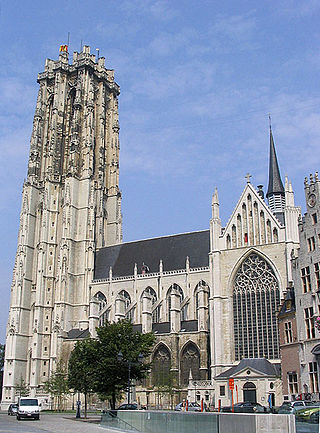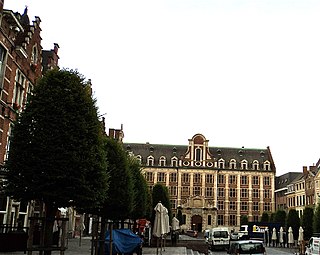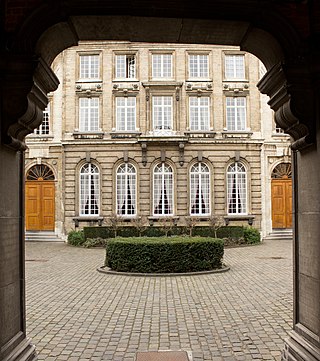
Deurle is part of the municipality of Sint-Martens-Latem located in the Flemish part of Belgium. Deurle is a picturesque small village near the borders of the river Lys and was added to Sint-Martens-Latem in 1977. Many well-known Flemish artists have lived in this village nested near a forest. Today, it is one of the best residential areas around Gent (Ghent), also counting numerous restaurants and bistros.

Brabantine Gothic, occasionally called Brabantian Gothic, is a significant variant of Gothic architecture that is typical for the Low Countries. It surfaced in the first half of the 14th century at St. Rumbold's Cathedral in the city of Mechelen.
Jean d'Oisy (1310–1377) was the architect of several ecclesiastical buildings in Brabantine Gothic style. He was one of the earliest introducers of northern French Gothic style into the Low Countries and a teacher of the reputed Brabantian architect Jacob van Thienen.

Beschermd erfgoed is the official term to describe Flemish National Heritage Sites listed by law to protect and spread awareness of Belgian cultural heritage, specifically in Flanders. The term is also used nationwide to refer to national heritage sites. Because Belgium is officially a tri-lingual country, the other nationwide terms used in the rest of the country are the French term Bien classé and the German term Kulturdenkmal.

Liezele is a village and deelgemeente (sub-municipality) of the municipality of Puurs-Sint-Amands in the province of Antwerp, Belgium. The village is located about 20 kilometres (12 mi) south-south-west of the city of Antwerp. On the night of 4 to 5 September 1914, the entire village was destroyed by the Belgian Army to deny the Germany Army cover.

Watervliet is a village in the Belgian province of East Flanders and suburb of the town of Sint-Laureins. Watervliet is part of the Meetjesland, and is adjacent to the Dutch border. It was a separate municipality until 1977.

The Flanders Heritage Agency is a cultural heritage agency sponsored by the Flemish Government. The organisation is split into four subdivisions; the former VIOE, which inventories Beschermd erfgoed in the Flemish Region; the agency "Ruimte en Erfgoed" which executes policy on heritage management and protection; the Ministry department of Town and County Planning, Housing Policy and Immovable Heritage, or Ruimtelijke Ordening, Woonbeleid en Onroerend Erfgoed (RWO), which supports the Minister of Culture on policy decisions; and Inspectie RWO, which is the inspection arm of the RWO.

Kruikenburg Castle is a listed building in the village of Ternat, Belgium. It was the seat of the lordship of Kruikenburg, which included the villages of Ternat, Sint-Katarina-Lombeek and Wambeek. A medieval foundation, the castle was extensively remodelled in the 16th and 18th centuries, giving it its current appearance. In 1662 the lord of Kruikenburg was elevated to the title of count. In the 20th century the castle became a house of the Lassalian Brothers.

The Irish College of St Anthony, in Leuven, Belgium, known in Irish: Coláiste na nGael i Lobháin, Latin: Hibernorum Collegii S. Antonii de Padua Lovanii, French: Collège des Irlandais à Louvain and Dutch: Iers College Leuven, has been a centre of Irish learning on the European Continent since the early 17th century. The college was dedicated to St. Anthony of Padua.

Trinity College was one of the colleges of Leuven University, dedicated to preliminary studies in the liberal arts. The college was established by the university authorities in 1657 to replace the "Collège de Gand" founded by Frans van de Nieulande in 1559, which had closed in 1655 for lack of funds. Building began in 1658, under the supervision of Jan du Can and Adriaan van Mechelen, and from 1659 the college was housed on the Old Market. It was sometimes known as "Collegium Novum". The college was sequestered when the university was closed down in 1797 during the French occupation. The buildings were sold at public auction in 1802. The southern wing, added in 1684, was demolished in 1813. The final remnants of the 17th-century buildings were destroyed by aerial bombardment in May 1944. Since 1843 a Josephite secondary-school, Heilige Drievuldigheidscollege, has stood on the location.
CornilCacheux was a French pipe organ maker.
The Groot Begijnhof Sint-Amandsberg is an eight-hectare beguinage in the Sint-Amandsberg suburb just outside the centre of the Belgian city of Ghent. It was built between 1873 and 1874 on the abandonment of the Old Saint Elisabeth Beguinage in the city centre. There is also a third beguinage in Ghent, that of Our-Lady Ter Hooyen.

Holy Ghost College was one of the colleges of Leuven University, now listed as built heritage of Flanders, Belgium.

St. Stefanus is a Catholic parish church in Ghent, Belgium, part of an Augustinian monastery. It is dedicated to St. Stephen. The present building dates from 1841.

The church of Our Lady, Melsele is a Roman Catholic parish church in Melsele, in the commune of Beveren, in East Flanders, Belgium. It is a registered heritage site.

Saint Ivo's College was a college at the Old University of Leuven that provided accommodation and facilities for poor students in the Faculty of Law. The founder was Robertus de Lacu, originally from Ghent, who had been professor of canon law since 1463. The college was dedicated to Ivo of Kermartin, the patron saint of lawyers, and was used by the law faculty for faculty meetings and ceremonies. The original library was destroyed by marauding Spanish soldiers in 1578, during the Dutch Revolt.
The Major Seminary in Ghent was an institution for the training of Catholic clergy for the diocese of Ghent, first founded in 1569. It has been established at three different locations in the city. Since 2006 diocesan clergy from Ghent have been trained in Leuven.

The Diocesan Pastoral Centre Mechelen is a centre for pastoral activities and ecclestical administration, which also houses the diocesan archive of the Archdiocese of Mechelen-Brussels. It is located on the two-acre site of what was formerly the Major Seminary in Mechelen, an institution for the training of Catholic clergy in the archdiocese from 1595 to 1970. Since 1936, increasingly extensive parts of the site have been listed with the status of a protected monument.

Arras College was a college at the Old University of Leuven that provided accommodation for poor students in the Liberal Arts who intended to train for the priesthood. The founder was Nicolaus Ruterius, Bishop of Arras, a native of the Duchy of Luxembourg who had been chancellor of the university and provost of St. Peter's Church, Leuven.















